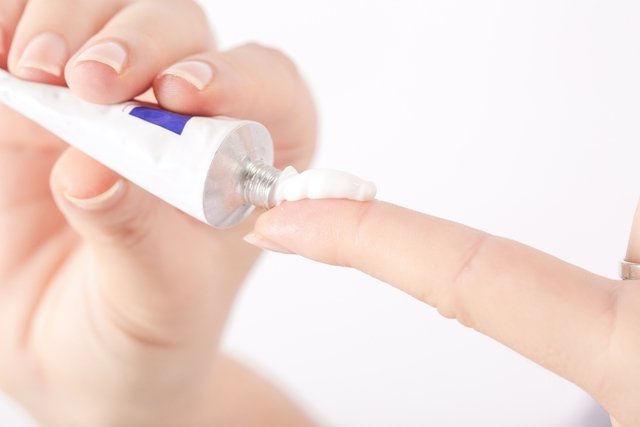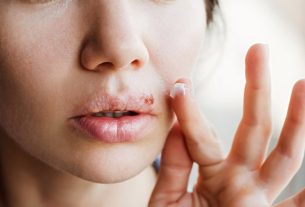Ointments for atopic dermatitis, such as dexamethasone, betamethasone, pimecrolimus or tacrolimus ointment, have anti-inflammatory or immunosuppressive action, which help to alleviate the symptoms of atopic dermatitis, control or prevent attacks.
Atopic dermatitis is a chronic inflammation of the skin, which can affect babies, children, teenagers or adults, causing symptoms such as dry skin, red plaques, intense itching or swelling of the skin.
Ointments for atopic dermatitis should be used under the advice of a dermatologist, after evaluating the symptoms, their severity, and the person’s age, and thus prescribing the best ointment on an individual basis. See which ointments are most suitable for the main skin problems.

Ointments for atopic dermatitis
The main ointments for atopic dermatitis are:
1. Betamethasone
Betamethasone ointment may be recommended by a dermatologist to help reduce inflammation in the skin, relieving symptoms of atopic dermatitis such as itching, swelling and redness of the skin.
Betamethasone is a corticosteroid that has potent anti-inflammatory action, and can be found in its generic form under the name “betamethasone dipropionate” 0.5 mg/g or “betamethasone valerate” 1mg/g, or under the trade names Diprosone or Betnovate, for example.
Betamethasone ointment should only be used under medical advice, as it can cause side effects such as skin atrophy, discoloration, stretch marks, or increase the risk of skin infections, for example, and should not be used by children under 1 year old , pregnant or breastfeeding women.
How to use: Apply a thin layer of the ointment to the affected skin, 1 or 2 times a day, as advised by the dermatologist, for a maximum of 4 weeks of treatment. See how to use betamethasone correctly.
2. Dexamethasone
Dexamethasone is another corticosteroid in the form of an ointment with powerful anti-inflammatory action, which works to control skin inflammation and relieve symptoms such as redness, swelling or itching of the skin, caused by atopic dermatitis.
This ointment can be found under the trade names Dexason or Cortitop, or in generic form under the name “dexamethasone acetate” 1 mg/g, and should not be used by children, pregnant women or people who are allergic to dexamethasone. or other corticosteroids.
Furthermore, corticosteroid ointments should be avoided in areas where the skin is thinner, such as the face, neck or groin, for example.
How to use: Apply to the affected skin region 2 or 3 times a day, massaging gently for better absorption, until symptoms improve. It is recommended to wash your hands and affected skin with water and neutral soap and dry well before applying the ointment. See how to use dexamethasone correctly.
Taking care of your health has never been easier!
3. Desoxymetasone
Desoximethasone ointment is also a corticosteroid ointment indicated for the treatment of atopic dermatitis, as it helps to reduce inflammation in the skin and alleviate the symptoms of dermatitis.
This ointment can be found in pharmacies or drugstores under the trade name Esperson dermatological cream 2.5 mg/g.
Desoximethasone ointment should not be used by babies or children under 6 years of age, during pregnancy or lactation, or by people who have perioral dermatitis or allergies to any other type of corticosteroid.
How to use: Apply a small amount of the ointment to the affected skin, massaging lightly, 1 to 2 times a day, as advised by your doctor. The duration of use of this ointment is a maximum of 4 weeks of treatment.
4. Fluticasona
Fluticasone is a topical corticosteroid that can also be indicated to alleviate the symptoms of atopic dermatitis, due to its powerful anti-inflammatory effect.
This ointment can be found under the trade name Flutivate, containing 0.5 mg/g (0.05%) of fluticasone propionate, and should only be used under medical advice.
Fluticasone ointment should not be used by children under 1 year of age, during pregnancy and lactation.
How to use: Apply a thin layer of the ointment to the affected skin, 1 to 2 times a day, as directed by the doctor, for a maximum of 4 weeks of treatment.
5. Neomycin
Neomycin ointment is generally found in combination with ketoconazole and betamethasone, and can be recommended by the doctor for the treatment of atopic dermatitis, when there are skin infections, as it has anti-inflammatory, antibacterial and antifungal actions.
This ointment can be found under the names Novacort, Cimecort or Cetobeta, and should only be used under medical advice, being contraindicated during pregnancy or breastfeeding, or by people who have skin infections caused by chickenpox, herpes simplex or zoster, cutaneous tuberculosis or cutaneous syphilis.
How to use: apply a thin layer of the ointment to the affected skin, 1 to 2 times a day, for a maximum of 2 weeks of treatment, as per medical advice.
6. Tacrolimus
Tacrolimus is an immunosuppressive ointment that works by reducing the action of the immune system, which helps to alleviate the symptoms of moderate to severe atopic dermatitis, when other treatments have not been effective in controlling symptoms or in cases of people who cannot tolerate other treatments.
Furthermore, this ointment can be indicated as a maintenance treatment to prevent new attacks of atopic dermatitis, or to alleviate symptoms and control attacks, and should only be used with medical advice, being contraindicated for children under 2 years of age. , pregnant or lactating women.
Tacrolimus ointment can be found under the names Tarfic or Atobach, in different doses, containing 0.3 mg/g (0.03%) of tacrolimus, which can be used by children aged 2 years to 15 years, or 1 mg /g (0.1%) of tacrolimus, indicated for adults and adolescents over 16 years of age.
How to use: for children between 2 and 15 years old, a thin layer of tacrolimus ointment 0.3 mg/g (0.03%) should be applied to the affected skin region, twice a day, for up to 3 weeks of treatment.
For adolescents over 16 years of age and adults, tacrolimus ointment 1 mg/g (0.1%) should be applied to the affected skin, twice a day, until the lesions disappear.
7. Pimecrolimo
Pimecrolimus ointment is another immunosuppressive ointment, it is generally indicated for mild to moderate atopic dermatitis, as it helps to alleviate symptoms such as redness or itching of the skin.
This ointment can be recommended by a doctor for babies from 3 months, children, teenagers and adults, found under the trade name Elidel.
Unlike corticosteroids, immunosuppressive ointments can be applied to areas with thinner skin, such as the face, neck or groin, after hydration, however, sun exposure should be avoided after application.
How to use: Apply a thin layer of the ointment to the affected skin, twice a day, massaging lightly until completely absorbed. The treatment time must be guided by the doctor.
In addition to ointments, in cases of generalized atopic dermatitis or atopic dermatitis that has not improved with topical treatment with ointments, the doctor may recommend treatment with corticosteroid tablets or immunosuppressants, for example. See all treatment options for atopic dermatitis.
Ointment for childhood atopic dermatitis
The treatment of childhood atopic dermatitis must be guided by a pediatrician or dermatologist and usually involves the use of moisturizers and emollients for the skin, in order to alleviate symptoms of itching, irritation, redness or swelling of the skin.
In some cases, the doctor may recommend the use of corticosteroid ointments, at the lowest possible dose and treatment time, immunosuppressive ointment, or antibiotic ointment, if the child has a skin infection.
It is important to emphasize that ointments for atopic dermatitis in babies or children should only be used with medical advice, after assessing the child’s health, severity of symptoms and age.
Care when using ointments
Some precautions when using ointments are important, such as:
- Wash the skin with water and neutral soapand dry well before applying the ointment;
- Wash your hands after applying the ointmentexcept in cases where the ointment is used to treat the skin of the hands;
- Apply the ointment at the right times as directed by the doctor;
- Make regular medical appointments to monitor the effectiveness of treatment and the emergence of side effects;
- Avoid taking medication on your own and without medical recommendation;
- Do not increase or decrease the dose of the ointment without having been advised by a doctor;
- Do not interrupt treatment on its own;
- Avoid sun exposureuse artificial tanning or phototherapy during treatment with ointments, as this can make the skin more sensitive;
- Wear cotton clothesavoiding those made of synthetic fabrics;
- Avoid using perfume or scented lotions on the skin;
- Avoid contact with substances that can develop or worsen symptomssuch as pollen or pool water;
- Avoid very hot environments that promote sweating;
- Avoid taking very hot and prolonged bathsas they dry out the skin;
- Dry your skin after bathing with a soft towel.
In addition, you should use the moisturizer on your skin recommended by your doctor daily to retain and maintain skin moisture, in addition to calming the skin, preventing it from drying out, worsening symptoms or the emergence of new attacks of atopic dermatitis. Know how to identify all the symptoms of atopic dermatitis.
It is important that this care is continued even when the symptoms of atopic dermatitis disappear to prevent the skin from becoming too dry.

Sign up for our newsletter and stay up to date with exclusive news
that can transform your routine!
Warning: Undefined array key "title" in /home/storelat/public_html/wp-content/plugins/link-whisper-premium/templates/frontend/related-posts.php on line 12
Warning: Undefined array key "title_tag" in /home/storelat/public_html/wp-content/plugins/link-whisper-premium/templates/frontend/related-posts.php on line 13



